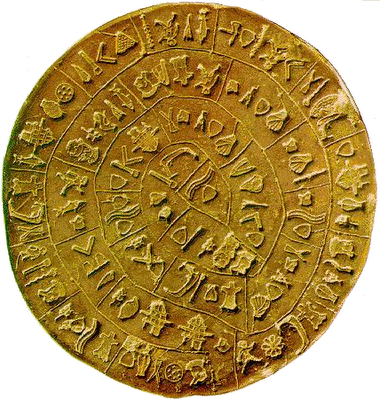Nestled within the ruins of the ancient Minoan palace site of Phaistos on the island of Crete, the Phaistos Disc stands as a silent enigma, echoing the mysteries of a civilization lost in the sands of time.
Discovered over a century ago, this 4,000-year-old artifact continues to baffle scholars and archaeologists alike, its surface adorned with 241 cryptic symbols that have resisted all attempts at decipherment.
The year was 1908 when Italian archaeologist Luigi Pernier unearthed the Phaistos Disc during excavations at the palace of Phaistos. This disc, made of baked clay and measuring about 16 centimeters in diameter, immediately captured the imagination of the archaeological community. Its circular surface, imprinted with a spiral arrangement of mysterious symbols, hinted at a sophisticated level of communication within the ancient Minoan civilization.

The symbols engraved on the Phaistos Disc are a unique combination of pictorial representations, each meticulously arranged in a spiral pattern. Among the 241 symbols, one can identify depictions of humans, animals, plants, and various inanimate objects. Despite the richness of these symbols, their meaning remains elusive, as they do not conform to any known writing system of the time.
Over the years, numerous linguists, archaeologists, and historians have attempted to unravel the secrets held within the Phaistos Disc. However, the lack of comparable linguistic samples and the absence of any bilingual inscriptions have rendered these attempts largely futile. The unique nature of the symbols and their arrangement has left scholars without a point of reference, making it challenging to establish a coherent system of decipherment.

The enduring mystery of the Phaistos Disc has given rise to a plethora of theories and speculations. Some scholars believe that the symbols represent an early form of writing, possibly a Minoan script yet to be deciphered. Others suggest that the disc could be a religious or ritualistic object, encoding sacred information known only to a select few.
One notable hypothesis proposes a connection between the Phaistos Disc and Linear A, another undeciphered script associated with the Minoan civilization. However, without concrete evidence linking the two, this remains a speculative avenue rather than a definitive solution.
The Significance of the Phaistos Disc:
Beyond its cryptographic allure, the Phaistos Disc holds profound significance for our understanding of the Minoan civilization. As the most extensive example of Minoan writing to date, its decipherment could provide invaluable insights into the culture, language, and daily life of this ancient society.

The Phaistos Disc, with its 4,000-year-old puzzle, continues to defy the efforts of modern scholarship. As technology and linguistic analysis tools advance, there is hope that one day the enigma of the Phaistos Disc will be unraveled, shedding light on the mysteries of the Minoan civilization. Until then, this ancient artifact remains a symbol of the enduring fascination and challenges that come with deciphering the secrets of the past.





